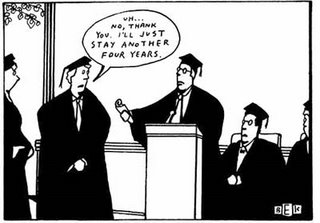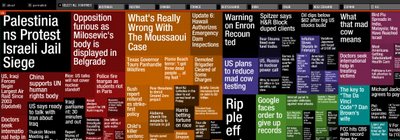
Okay,
Tom, how is this for the
press release of tomorrow? Per Tom Foremski's rant
("Die, Press Releases, Die! Die!") about what we
agree is an outmoded communications vehicle, the SHIFT team reformatted a press release that had been sent out earlier this month,
"Foremski-style."
Tom had asked for lots of links, news-without-spin, photos, financial data, tags to other stories, executive and analyst quotes, etc.
Note that we could have provided more of each of these elements, but in this case were restricted to what'd already been approved for this early-Feb press release.
...But, then again, using the
"More information available by request" device builds-in opportunities for agencies to add further value by offering up exclusive content, client interviews, etc. This might not suit Mr. Foremski - he seemed to want everything bound up in a hermetically-sealed package - but, the PR agency cannot abdicate
all opportunities to add value to the mainstream media.
Feedback welcome (from everybody)!
And, p.s. - part 3 of the "Bad Advice About Customer References" series will be posted tomorrow.
Feb. 6, 2006: UGOBE launches first product at DEMO 2006
Contact:
Todd Defren, SHIFT Communications, 617-681-1253
Description:
UGOBE, a new company started by Furby co-creator Caleb Chung, today revealed its first product, Pleo. Pleo is modeled after a one-week-old Camarasaurus Sauropod, or long neck dinosaur, and has been specifically engineered to mimic life with organic movement and behaviors. UGOBE’s patented robotic technology enables Pleo to move in a fluid, lifelike way, behave autonomously, convey emotions through motion and sound, and evolve in behavior over time. Pleo will be available in Q3 2006 and will MSRP for $199.
Executive Quote (more available by request):
“UGOBE’s goal is to re-animate life by transforming inanimate objects into lifelike creatures exhibiting organic movement and behaviors. Through evolving companionship, Pleo will suspend disbelief by bringing magic and beauty to life.” – Bob Christopher, CEO, UGOBE
Analyst Quote (more available by request):
“With this flagship product, UGOBE has shown that they are a forward-thinking company that sees the shift within the industry toward interactive organic robotics.” – Tim Bajarin, president, Creative Strategies
Financial Information:
- Private company
- Venture capital backed
- Series A funding: $2.5 million
- Series B funding: Plans to raise $5 million
- Investors Include:
- Band of Angels
- FMG, headed by Chauncey Shey, president and CEO, Softbank China Holding (SBCH); CEO, Softbank China Venture Capital (SBCVC); and co-founder and director, UTStarcom, Inc (NASDA: UTSI).
Photos (more available by request):

Videos:
Relevant Coverage To-Date:
- Associated Press, “Robotic Toys Are Going the Way of the Dinosaurs,” Matthew Fordahl, 2/7/2006
- USA Today, “New Tech Stuff Protects, Organizes, Amuses,” Ed Baig, 2/8/2006
- Washington Post, “Overwhelmed With Gadgets? Here's a Dinosaur,” Leslie Walker, 2/9/2006
- Newsweek, “Start-ups: Treats, Toys and Tech. Oh, My!” Brad Stone, 2/11/2006
- PC Magazine, “Can Pleo Robot Charm the Market?” Lance Ulanoff, 2/6/2006
Boilerplate:
UGOBE develops and markets revolutionary robotic technology that transforms inanimate objects into lifelike creatures that exhibit stunning organic movement and dynamic behaviors. Ugobe’s multidisciplinary team of robotics experts, animators, technologists, scientists, biologists and programmers are led by polymath toy inventor and Furby co-creator, Caleb Chung, one of the most successful and respected toy creators in the $25 billion U.S. toy industry. UGOBE’s groundbreaking line of robotic creatures called Life Forms, promise to inspire and entertain the child in all of us. For more information about UGOBE, visit www.ugobe.com.
UPDATE: Well, Tom seems to like it, anyway.
 A very cool newbiz prospect entered our pipeline this week. A name-brand consumer tech company has extended an invite to their RFP. We've made some great headway in our Lifestyle Technologies Group, with clients such as Shimano, Oakley, Ugobe, etc., and it would be sweet to add this company to the roster, too.
A very cool newbiz prospect entered our pipeline this week. A name-brand consumer tech company has extended an invite to their RFP. We've made some great headway in our Lifestyle Technologies Group, with clients such as Shimano, Oakley, Ugobe, etc., and it would be sweet to add this company to the roster, too.
































